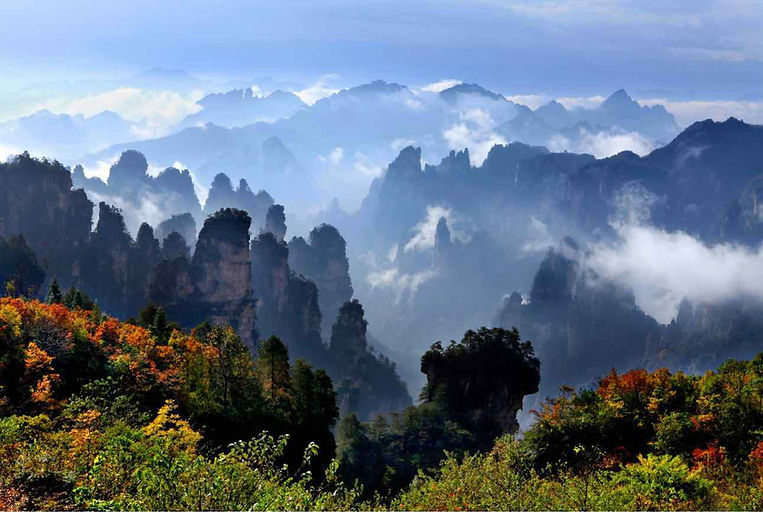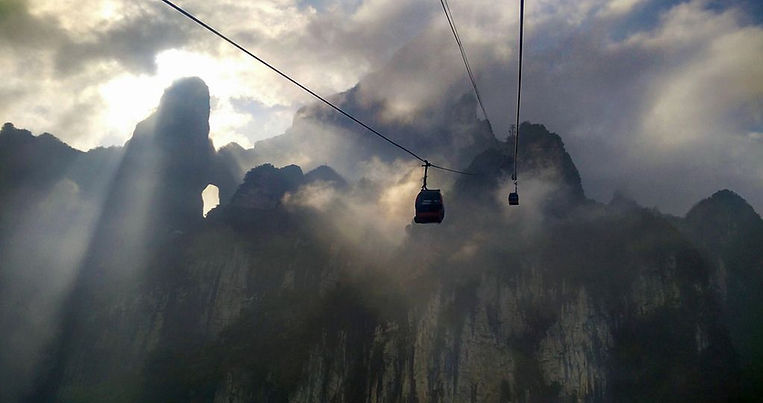Zhangjiajie National Forest Park and Tianmen Mountain — Picturesque Landscape and Exceptional Geoparks
Zhangjiajie, Zhangjiajie National Forest Park, and Tianmen Mountain
Brief Introduction to Zhangjiajie National Forest Park
Impressive Attractions of the Zhangjiajie National Forest Park Area
Brief Introduction to Tianmen Mountain
Impressive Attractions of Tianmen Mountain

Zhangjiajie National Forest Park in Hunan Province of China
Relationship Between Zhangjiajie, Zhangjiajie National Forest Park, and Tianmen Mountain
Zhangjiajie is a city in Hunan Province known for two famous mountains:
-
Zhangjiajie National Forest Park, renowned for its narrow sandstone pillars and peaks.
-
Tianmen Mountain, known for its Karst landscapes.
Zhangjiajie city was originally a small town named after Zhang Liang (? — 189 BC), a successful statesman who assisted Emperor Liu Bang in building the Han Dynasty (202 BC — 220 AD).
After stabilizing the Han empire, Zhang Liang resigned, relinquishing all power and noble titles.
He sought solace in a beautiful place, where he practiced Taoism.
This serene location later became known as Zhangjiajie, signifying Zhang's homeland.

Autumn View of Shentang Gulf in Zhangjiajie, Photo by Liu Ying.
Brief Introduction to Zhangjiajie National Forest Park
The Zhangjiajie National Forest Park is a crucial component of the Wulingyuan Scenic and Historic Interest Area, designated as a UNESCO World Heritage site.
As a World Geopark, it is home to a vast array of plant and animal species.
The park boasts over 3000 quartzite sandstone pillars, with some believed to have inspired the Floating Mountains featured in the movie Avatar.

Prototype of Avatar Hallelujah Mountain in Zhangjiajie National Forest Park — The Pillar of Southern Heaven
Zhangjiajie National Forest Park Attractions
Grand Stone Bridge, or Tianxia Diyi Qiao
A famous natural stone bridge (50 meters long, 350 meters high) connected two peaks near where some people see deities in local legends.

The Highest Natural Stone Bridge that Connects Two Peaks, Photo from Official Site of Zhangjiajie National Forest Park.

Stunning Peaks of Tianzi Mountain in Wulingyuan Scenic Area of Zhangjiajie, Photo by Dongfang IC.

Suspending Terrace, or Kongzhong Tianyuan, in Laowuchang Scenic Area of Zhangjiajie, Photo from HPA.

Shentang Gulf, A Restricted Area in Zhangjiajie with Mysterious Sounds and Dangerous Legends, Photo by Zhao Xin.

Golden Whip Brook or Jinbianxi, Photo from Official Site of Zhangjiajie National Forest Park.

Ten Mile Gallery, or Shili Hualang, A Picturesque Valley Consists of Stunning Peaks, Rivers, and Plants, Photo from Official Site of Zhangjiajie National Forest Park.

326 Meters' Bailong Elevator or Bailong Tianti in Wulingyuan Scenic and Historic Interest Area, the World's Tallest Outdoor Lift, Photo from Official Site of Zhangjiajie National Forest Park.

Beautiful Baofeng Lake or Baofeng Hu in Zhangjiajie, Photo by Ma Li.
Tianmen Mountain
Tianmen Mountain was initially named the Mountain of Dream, with its main peak standing as the tallest (1518.6 meters) in the Zhangjiajie area.
It earned its current name from a natural cave that emerged suddenly during the Three Kingdoms Era (220 — 280), resembling a gate to the holy heaven.
Hence, the mountain is aptly named Tianmen (Gate to Heaven).

Natural Stone Gate in Tianmen Mountain
Impressive Attractions of Tianmen Mountain

Tianmen Mountain Cableway, 7455 Meters Long with A Climbing Angle of 38 Degrees, Photo by Fengkuang Dongge.
.jpeg)
Twisted Winding Road, or Tongtian Dadao, Along the Tianmen Mountain in Zhangjiajie.

1600 Meters' Long Plank Path, or Guigu Zhandao, Along Steep Cliffs of Tianmen Mountain, Photo from Official Site of Zhangjiajie.

Tianmenshan Temple, Firstly Built in the Tang Dynasty (618 —907) and Rebuilt Several Times, Photo from the Official Site of Zhangjiajie.
Other Impressive Attractions in Zhangjiajie City

Glass Bridge in Zhangjiajie Grand Canyon, the 430 Meters Long and 300 Meters Tall Glass Skywalk, Photo from Official Site of Zhangjiajie.

Yellow Dragon Cave or Huanglong Dong, An Over 100, 000 Square Meters Large Karst Cave, Photo from Official Site of Zhangjiajie.

Beautiful Hibiscus Town, or Furong Ancient Town, Near Zhangjiajie and Its Tujia Culture.

Zushidian Palace complex in Laosicheng Site, A Political, Cultural, and Economical Center of Pengshi Tusi that was Built in the Year 1135, Photo by Lu Ruisheng.
You Might Also Like:
Holy Land of Politic and Worship in Chinese Culture — Mount Tai
The Precipitous Mountains and Root of Chinese Culture — Mount Hua
Magnificent Hanging Temple on Steep Cliff — Mount Heng North
Grand Cultural Landscape and Representative of Longevity — Mount Heng South
Grand Geopark and The Centre of Heaven and Earth — Mount Song
Sacred Taoism Place and Picturesque National Geopark — Wudang Mountains
Multi-Religions Mountain with Stunningly Beautiful Scenery — Mount Lu
Holy Buddhism Mountains with Golden Summit — Mount Emei
Buddhism Holy Land and Valuable Ancient Temples — Mount Wutai
Biodiversity Mountain and Mysterious Millennial Cultures — Mount Wuyi
Magnificent Cultural Landscape — Huangshan Mountain
Cultural Meanings of Extraordinary Attractions in China
Cultural Symbol Across Time and Space — Yellow River or Huang He River
Longest River of China — Yangtze River or Chang Jiang River
Legend, History, and Culture of Chinese Lakes
Ancient Towns with Exceptional Values
